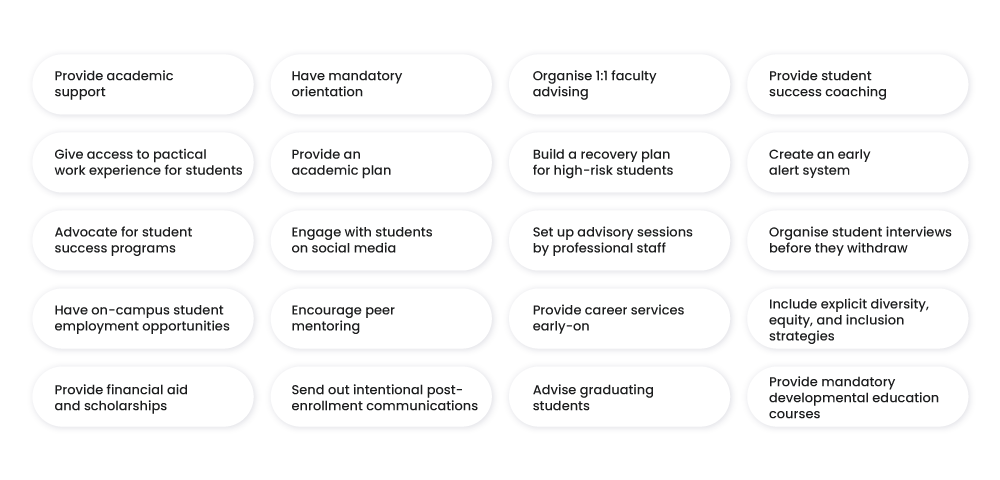It hurts to lose a new student—two times over, making it more important for institutions to invest in student retention strategies.
Students that desert their studies are likely to have burned through thousands of dollars and may be saddled with debt—without the increased earning power college graduates accrue. They tend to get lower-paying jobs and fewer professional opportunities.
The dropout student has no upside for your school either. Obviously, you invest significant resources in bringing in students and have vested interest in retaining them.
Cut to the chase- You have only one option-You need to know how to support students who need help. Let’s dig into the ways in which it’s done.
What is student retention in higher education?
The definitions vary. Most say retention is measured by going forward in a program from the first semester to second, or the first year to the second. Others think of it as the simpler examination of moving closer to graduation each year.
For reasons already discussed, losing students is a bad thing all around. The students you don’t retain, don’t graduate from your college, or often, any college.
Usually, a combination of factors triggers the student’s decision to leave college. A study from Griffith University indicates the reasons may include:
- Personal difficulties
This is the most common explanation, and it relates to health, finances, family, work, and difficulty fitting in or making friends. - Academic difficulties
Challenges here include lack of academic preparedness and weak academic knowledge or study skills. Weak academic entry scores and low GPAs in first semester are associated with greater attrition - Full time vs. part-time status
Part-time students are significantly less likely to continue into second year compared to full-time students - Wrong choice
Making an uncertain or the wrong choice for the school or area of study is linked to attrition. - Loss of interest
Students lose in the program or subject area. - Too demanding
The student is unable to manage the time and workload demands. - Dissatisfaction
Students may leave because they are unsatisfied with the college experience, the quality of curriculum, or teaching.
Recognizing the obstacles at hand, it is clear that devising strategies to retain students is necessary. Here are a few established student retention strategies to kick-start your efforts.
12 Student Retention Strategies in Higher Education
It’s essential to create retention strategies for every step of a student’s journey.
Simply stated, you need to execute strategies and best practices to improve the student experience from the day your future superstar clicks a button on your website to the day they graduate.
We’re talking about student engagement, which is the key to improving the quality of the academic experience and strengthening the university-student relationship.
“Student engagement represents two critical features of collegiate quality. The first is the amount of time and effort students put into their studies and other educationally purposeful activities. The second is how the institution deploys its resources and organizes the curriculum and other learning opportunities to get students to participate in activities that decades of research studies show are linked to student learning.”
National Survey of Student Engagement
We’ve tapped into several resources and experts to bring you a list of 12 ideas to help reverse course if retention’s been creeping south—or to drive mediocre retention numbers northward.
1. Define success for students
What’s student success? Define it and share it with your students so they understand what’s expected of them. Students are far more likely to proceed with passion when they understand the goals, the steps it takes to reach them, and importantly, the resources that can help them achieve them.
2. Help students track their progress
CampusGroups claims you can help keep students engaged in achieving their goals by guiding them with interactive tools such as to-do lists and pathways. They say students experience “intentional engagement” for:
- Reaching goals with co-curricular pathways, organized goals, checklists for event planning and certification programs
- Communicating exactly how to get and earn credits and track progress
Mapping out milestones is a highly effective way to encourage students to graduate, according to Hanover Research. Milestones are step-by-step goals that help students monitor their progress. The research offers examples of measurable milestones including:
- Earn one-year of college-level credits
- Complete general education coursework
- Transfer from community college to a four-year institution
- Complete needed remediation
3. Engage with your students regularly
Too often, students don’t reach out for help—with academic or social needs—because they don’t know how. Guidance and support from a professor or advisor can go a long way toward helping students work through their challenges and stay on-course.
Here are some tips to stay connected with your students:
- Connect early and often with programs to help students build relationships with the staff, faculty, and advisors as well as peers and student leaders.
- Design effective orientation programs and consider easily accessible virtual components or program options. An on-boarding or “getting started” checklist may be a good complement to your orientation program.
- Take advantage of opportunities to help students learn about campus services and the community.
- Implement an academic success program to support at-risk students with “success” courses, study sessions to promote achievement, and academic coaching.
- Offer students mentoring programs to develop important life skills.
- Offer technology that makes it easy to connect and book meetings with advisors, faculty, and staff.
- Use communication tools to check-in and follow-up with students in need and track the engagement metrics.
4. Build community
Don’t assume students will find their path on their own. Aim to cultivate a sense of belonging with programs to build community in and out of the classroom. Students who feel supported are more likely to perform well in school.
In the post-pandemic student life, they often struggle to juggle between online and in-classroom experiences. Many struggle to work in group projects or don’t have a sense of belonging.
Commit to developing supportive programs and communications specifically focused on increasing a sense of belonging. Consider establishing a network of peer mentors to engage with first year students.
5. Encourage students to get involved
It’s important to help enrich the overall student experience by connecting them with opportunities to get involved outside the classroom. Consider conducting involvement fairs (virtual or in-person) for students to visit, ask questions and learn more about organizations with positive experiences to offer beyond their studies.
Accommodate the challenges non-traditional students face
Many students have work and family responsibilities. Aim to deliver options and programs so they can thrive.
- Wherever possible, offer flexible schedules such as recorded lectures and weekend and evening classes.
- Online courses can increase retention. Offering digital courses improves outcomes by helping students earn their degree faster. Additionally, online classes offer disadvantaged students greater access to education. Tailor your online portfolio to the specific needs of your student population.
- Offer affordable child care options for students who are parents.
- Implement easily accessible virtual student life programs and groups that accommodate non-traditional students.
6. Help students with opportunities to access financial resources
Finances are an obvious issue for a large sector of your student body.
- Inform students about jobs, scholarships and grant opportunities in your communications.
- Help students access professional opportunities on campus and in the community with a centralized job board.
- Develop payment plans that give students and their families options to cover the costs of tuition and other expenses.
7. Communicate with parents
Keep parents informed about their child’s progress and the ways in which your college supports students with services for mental health counseling, tutoring, academic advising and more. If you need to intervene, you may want to conduct online meetings with the family.
8. Gather student feedback
One of the best ways to prevent students from leaving school is by regularly collecting feedback to gauge student happiness and program effectiveness. Use surveys to get to know your students, how they feel, what struggles they’re experiencing, what they like, and more. Feedback sourced directly from students will deliver the insights you need to address issues quickly and optimize your programs.
According to a Student Satisfaction report by Studyportals, measuring student satisfaction:
- Helps colleges understand which areas are exceeding expectations and can be used to promote the institution, and which areas need improvement
- Enables colleges to understand their ability to achieve students’ well-being and keep them motivated and engaged
- Allows colleges to align their strategy with their mission and objectives
9. Measure student retention KPIs
Identify, measure, and track student retention KPIs and distribute the data to members of the leadership team, so they know how their programs are performing.
Additionally, you should have quantitative data (education history, employment status, etc.) and qualitative data (goals, motivations, and obstacles) that can be used to extract predictive models for student success. The data should help inform proactive retention strategies.
Of course, you won’t get far unless you have dependable data collection and analytic components in place. Spreadsheets won’t do.
You need a higher education CRM like LeadSquared that can integrate with your existing systems like SIS to create an efficient way to share student information across departments.
10. Track high-risk students
Tap into engagement analytics early and often to identify indicators that suggest students may be struggling and at risk for dropping out and track them. Then, configure automated alerts to inform the proper staffer to engage and help.
11. Set up early interventions
Develop an ongoing assessment and intervention plan to equip at-risk students with increased support and services ASAP. When students appear to be experiencing academic, personal, financial or social issues, inform them about the resources you offer that can help them address their needs.
12. Encourage discussion forums
Regularly reaching out to students as well as providing them with access to counselors is equally crucial. From admission to graduation, it is important for students to have complete visibility into their interactions with counselors, advisors, and professors. This helps the institute gain valuable insights into the student’s retention journey.
THE TOP 20 STRATEGIES AND TACTICS FOR STUDENT SUCCESS, RETENTION, AND COMPLETION

To drive the student success that’s inextricably tied to retention, your institution should marshal its resources, gain commitment leaders and all involved, embrace innovation, relentlessly measure and evaluate, and base decisions on solid evidence.
A robust student retention program can improve the quality of your college and reduce college attrition rates. Your student retention strategies should be reviewed regularly by all relevant constituents and refined as needed.
Source: Effective Practices for Student Success, Retention and Completion Report, RNL 2021
To drive the student success that’s inextricably tied to retention, your institution should marshal its resources, gain commitment leaders and all involved, embrace innovation, relentlessly measure and evaluate, and base decisions on solid evidence.
A robust student retention program can improve the quality of your college and reduce college attrition rates. Your student retention strategies should be reviewed regularly by all relevant constituents and refined as needed.
Meaningful progress on student success will not happen overnight. Institutions should foster the culture, skill sets, and infrastructure necessary to support a student-focused environment. As the magnitude of the challenge grows, institutions that start down this path sooner, rather than later, are most likely to see significant results.
Deloitte Insights
Success By Design—Improving Outcomes in American Higher Education









